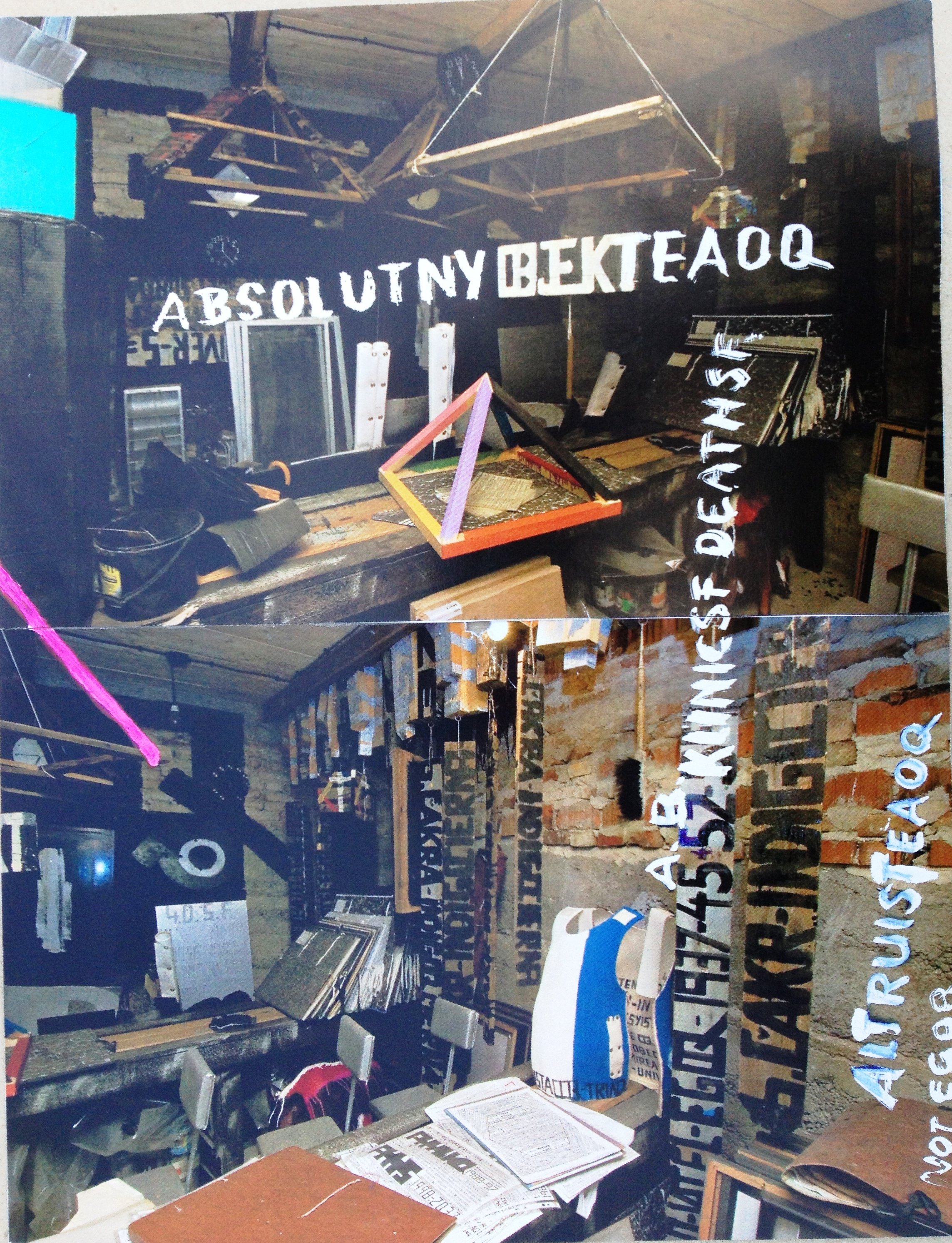Archive Room
Lower Level, Foyer

From the cycle Sketches from Snežienková / Z cyklu Skice zo Snežienkovej, ca. 2005
Photo on colored paper, montage, felt-tip pen, whitening liquid, perforation
30×23cm
After his return from the USA in 1990, Filko’s System SF became more and more of a sprawling meta-system by means of which he rearranged and reconsidered the entirety of his artistic work. A dynamic was set in motion that led to Filko reworking and redating many earlier works. In this process the Archive SF came about, an ongoing depot with about 80 different ordering components and a comprehensive system for cataloguing sketches, smaller objects, text art, photographs, and many archive materials.
In the archive room in the exhibition, we present a large number of items that provide insight into this fascinating ordering and semiotic system and other physical objects that are situatively interconnected with it. Art and life here form an indivisible unity, as becomes immediately clear at the entrance to the archive, which consists of two doors painted by Filko.
Visitors can use a screen to gain further insight into selected archive material. Various thematically connected objects are displayed in this room, supplemented by projections of historical exhibition views and further images from the archive. The text-images “Subject” and “Object” are written in white and black on wooden boards, and also the word EGO. Archive SF is situated in the realm between the totality of the ego (black) and self-dissolution of the artistic self through transcendence (white). Two photographs from a vernissage are also characterized by these two opposites, showing visitors overpainted in white and Filko as the only person in black. Filko saw his entire system as “psychophilosophy,” whereby material forms of expression are reconceived as mirrors of psychic states of mind.
There are also works here that present text in each of the first four colors of the fully developed System SF, red, orange, yellow, and green. The two smaller ones show the links between the four colors and the four elements, while the largest of these three works also links the colors up with the signs of the compass: red (1st chakra, earth/east), orange (2nd, fire/south), yellow (3rd, air/west), green (4th, water/north).
A further larger work also contains different dates that are each connected with the three “clinical deaths” that Filko himself said he experienced after serious accidents. Filko presented this story of his clinical deaths with great conviction, but also to add to the mythical construction of his artistic personality.
Other works address Filko’s famous artist’s studio Snežienková, in the northern outskirts of Bratislava. A marginally reworked street sign becomes an autonomous work, presenting the three colors of Filko’s dimensions, red, white, and blue. The artist himself can be seen on the roof of his studio in two photographs, while other pictures show the interior. All of the studio’s rooms are arranged according to the colors and phases of Filko’s work, so that they themselves are an integral part of Archive SF. Many works are laid out on the floor, walls, and ceiling, forming a total work of art in conjunction with the building itself, permitting no separation between art and life. Filko’s studio is a clear impression of the totality and universal approach of his artistic personality.
A video interview with Hans Ulrich Obrist and Stano Filko (translation: Roman Ondak) (2006) provides insight into Filko’s famous artist’s studio Snesčenkova and his division of the rooms there according to the seven phases of System SF. The video was produced by the well-known Swiss curator Obrist and then given subtitles by the Slovak National Gallery. An adapted version is published in the catalog.
The artworks in the archive space as well as the digital video archive were compiled especially for this exhibition by Lucia Gregoravá Stach, curator at the Slovak National Gallery in Bratislava.
FILKO, ca. 1995
Found object, paint, wood
198 x 85 cm
Courtesy Peter Petrička, Bratislava
Door (UISFO EGOQ) / Dvere (UISFO EGOQ), ca. 2000
Found object, mixed media, acrylic, glas, wood
190,5 x 120 x 10 cm
SF Clinical Deaths / SF Klinické smrte, 1995
Installation, Mixed media
Piece of wood, drawing, plastic slide sleeve
22 x 18 x 4 cm, 42 x 29,7 cm, 23 x 27,6 cm
From the series Four elements (Earth, Air, Fire, Water) / Zo série Štyri živly (Zem, Vzduch, Oheň, Voda), ca. 1990
Paint, cord, mirror
26 x 42 cm
From the series EGO (Four Elements) / Zo série EGO (Štyri živly), ca. 1995
Acrylic, cord, plastic
30,5 x 30,5 cm, 36 x 32 cm
From the series EGO (Four Sides of the World) / Zo série EGO (Štyri svetové strany), ca. 1995
Acrylic, found material
61 x 41 cm
Subject – Object / Subject – Object, ca. 1995
Wood, arcyl, cord, steel plummet
120 x 39 x 8 cm
From the series EGO / Zo série EGO, ca. 1995
Paint, wood, hardboard
100 x 74 cm
From the cycle EGO / Z cyklu EGO, ca. 1995
Wood, acrylic, cord
60 x 23 x 25 cm
Birth of SF / Narodenie SF, 1960er-Jahre
Mixed media, found objects
110 × 60 × 60 cm
Street name sign (Snežienková Street) / Uličná tabuľa (Snežienkova ulicá), ca. 1990
Found material, paint, metal
30 × 70 cm
Hans Ulrich Obrist & Roman Ondak
Video, 52,31 min.
Interviewer: Hans Ulrich Obrist, Roman Ondak
Edit & Subtitles: The Slovak National Gallery, Bratislava
All works if not otherwise stated Courtesy Linea Collection, Bratislava; Layr, Vienna